Page 239 of 424
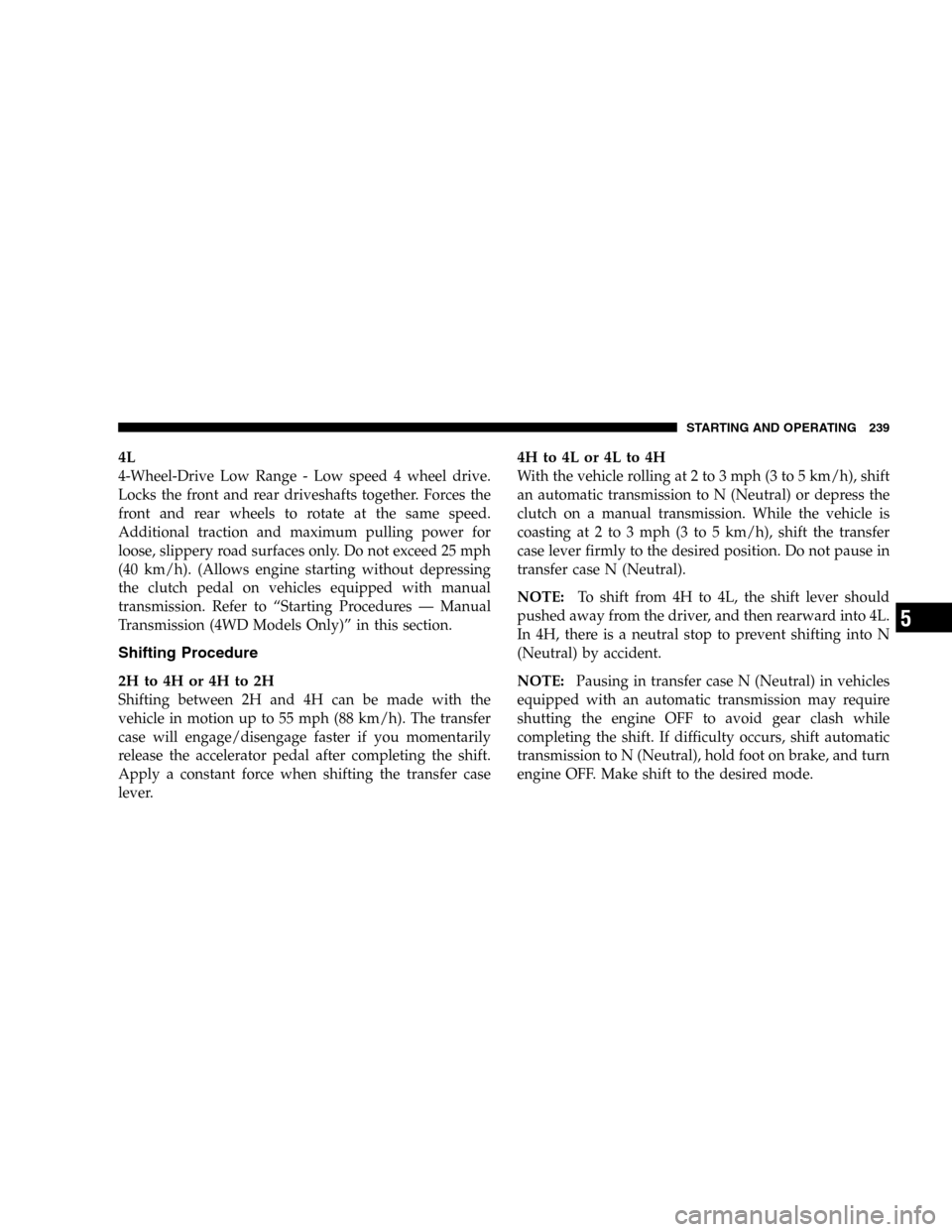
4L
4-Wheel-Drive Low Range - Low speed 4 wheel drive.
Locks the front and rear driveshafts together. Forces the
front and rear wheels to rotate at the same speed.
Additional traction and maximum pulling power for
loose, slippery road surfaces only. Do not exceed 25 mph
(40 km/h). (Allows engine starting without depressing
the clutch pedal on vehicles equipped with manual
transmission. Refer to “Starting Procedures — Manual
Transmission (4WD Models Only)” in this section.
Shifting Procedure
2H to 4H or 4H to 2H
Shifting between 2H and 4H can be made with the
vehicle in motion up to 55 mph (88 km/h). The transfer
case will engage/disengage faster if you momentarily
release the accelerator pedal after completing the shift.
Apply a constant force when shifting the transfer case
lever.
4H to 4L or 4L to 4H
With the vehicle rolling at 2 to 3 mph (3 to 5 km/h), shift
an automatic transmission to N (Neutral) or depress the
clutch on a manual transmission. While the vehicle is
coasting at 2 to 3 mph (3 to 5 km/h), shift the transfer
case lever firmly to the desired position. Do not pause in
transfer case N (Neutral).
NOTE:To shift from 4H to 4L, the shift lever should
pushed away from the driver, and then rearward into 4L.
In 4H, there is a neutral stop to prevent shifting into N
(Neutral) by accident.
NOTE:Pausing in transfer case N (Neutral) in vehicles
equipped with an automatic transmission may require
shutting the engine OFF to avoid gear clash while
completing the shift. If difficulty occurs, shift automatic
transmission to N (Neutral), hold foot on brake, and turn
engine OFF. Make shift to the desired mode.
STARTING AND OPERATING 239
5
Page 243 of 424
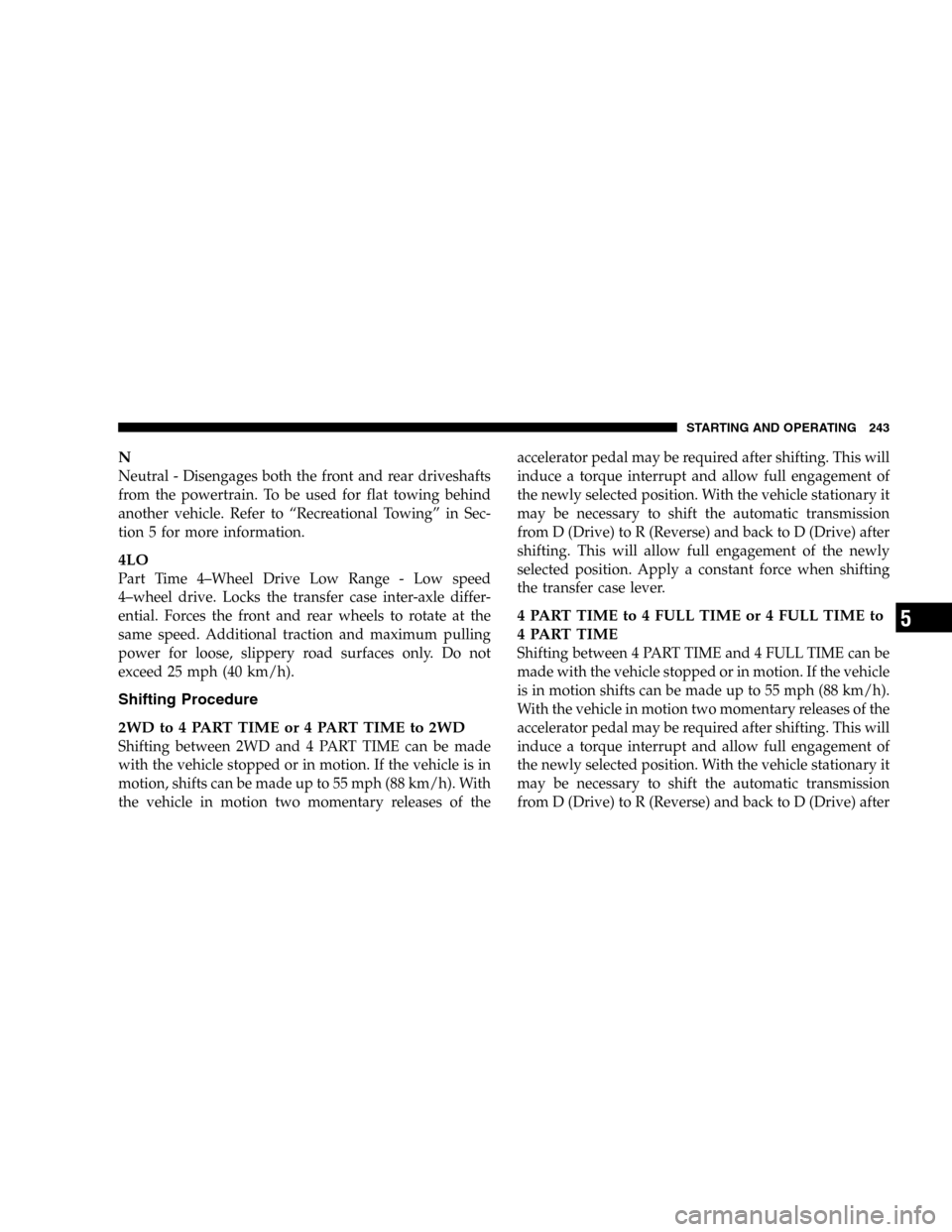
N
Neutral - Disengages both the front and rear driveshafts
from the powertrain. To be used for flat towing behind
another vehicle. Refer to “Recreational Towing” in Sec-
tion 5 for more information.
4LO
Part Time 4–Wheel Drive Low Range - Low speed
4–wheel drive. Locks the transfer case inter-axle differ-
ential. Forces the front and rear wheels to rotate at the
same speed. Additional traction and maximum pulling
power for loose, slippery road surfaces only. Do not
exceed 25 mph (40 km/h).
Shifting Procedure
2WDto4PARTTIMEor4PARTTIMEto2WD
Shifting between 2WD and 4 PART TIME can be made
with the vehicle stopped or in motion. If the vehicle is in
motion, shifts can be made up to 55 mph (88 km/h). With
the vehicle in motion two momentary releases of theaccelerator pedal may be required after shifting. This will
induce a torque interrupt and allow full engagement of
the newly selected position. With the vehicle stationary it
may be necessary to shift the automatic transmission
from D (Drive) to R (Reverse) and back to D (Drive) after
shifting. This will allow full engagement of the newly
selected position. Apply a constant force when shifting
the transfer case lever.
4 PART TIME to 4 FULL TIME or 4 FULL TIME to
4 PART TIME
Shifting between 4 PART TIME and 4 FULL TIME can be
made with the vehicle stopped or in motion. If the vehicle
is in motion shifts can be made up to 55 mph (88 km/h).
With the vehicle in motion two momentary releases of the
accelerator pedal may be required after shifting. This will
induce a torque interrupt and allow full engagement of
the newly selected position. With the vehicle stationary it
may be necessary to shift the automatic transmission
from D (Drive) to R (Reverse) and back to D (Drive) after
STARTING AND OPERATING 243
5
Page 244 of 424
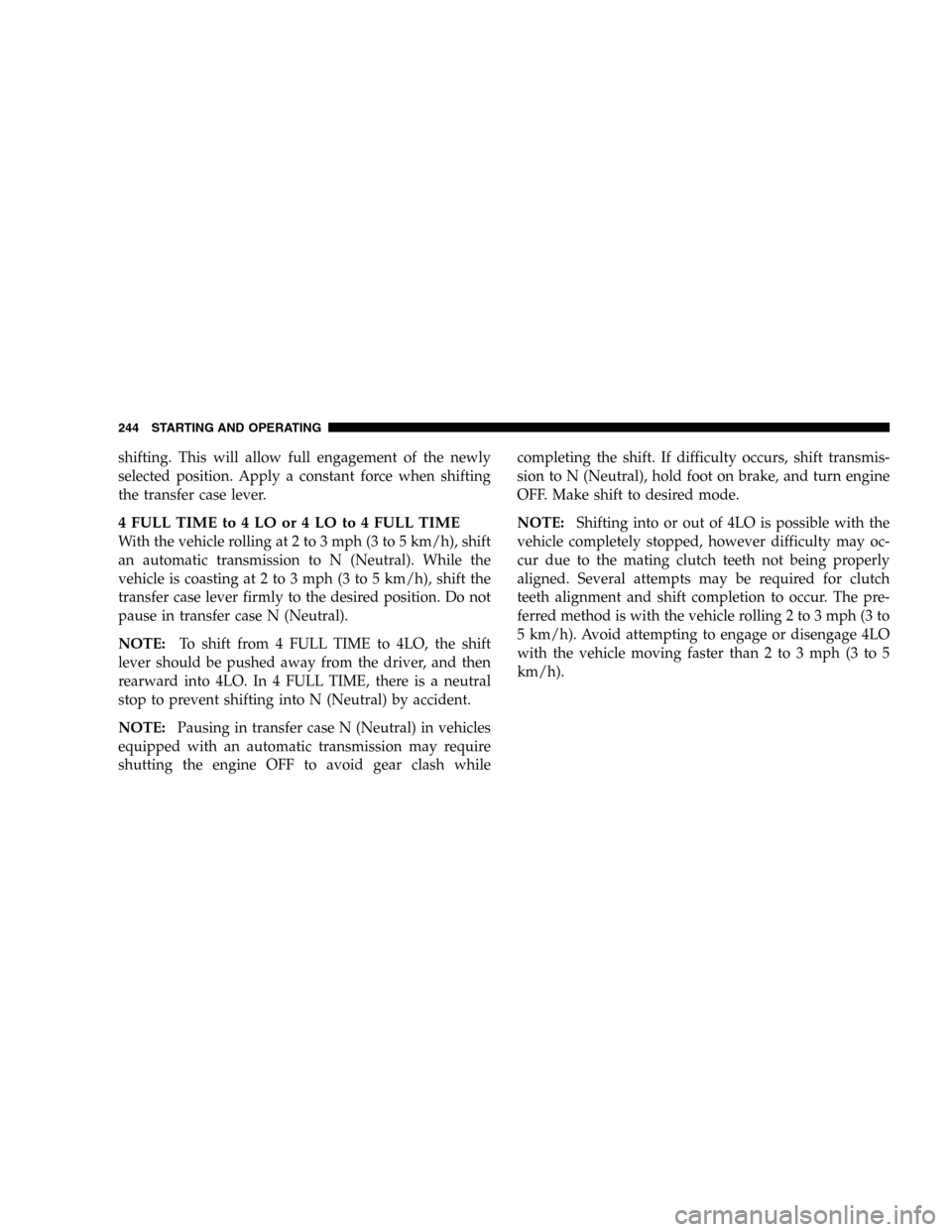
shifting. This will allow full engagement of the newly
selected position. Apply a constant force when shifting
the transfer case lever.
4 FULL TIME to 4 LO or 4 LO to 4 FULL TIME
With the vehicle rolling at 2 to 3 mph (3 to 5 km/h), shift
an automatic transmission to N (Neutral). While the
vehicle is coasting at 2 to 3 mph (3 to 5 km/h), shift the
transfer case lever firmly to the desired position. Do not
pause in transfer case N (Neutral).
NOTE:To shift from 4 FULL TIME to 4LO, the shift
lever should be pushed away from the driver, and then
rearward into 4LO. In 4 FULL TIME, there is a neutral
stop to prevent shifting into N (Neutral) by accident.
NOTE:Pausing in transfer case N (Neutral) in vehicles
equipped with an automatic transmission may require
shutting the engine OFF to avoid gear clash whilecompleting the shift. If difficulty occurs, shift transmis-
sion to N (Neutral), hold foot on brake, and turn engine
OFF. Make shift to desired mode.
NOTE:Shifting into or out of 4LO is possible with the
vehicle completely stopped, however difficulty may oc-
cur due to the mating clutch teeth not being properly
aligned. Several attempts may be required for clutch
teeth alignment and shift completion to occur. The pre-
ferred method is with the vehicle rolling 2 to 3 mph (3 to
5 km/h). Avoid attempting to engage or disengage 4LO
with the vehicle moving faster than 2 to 3 mph (3 to 5
km/h).
244 STARTING AND OPERATING
Page 284 of 424
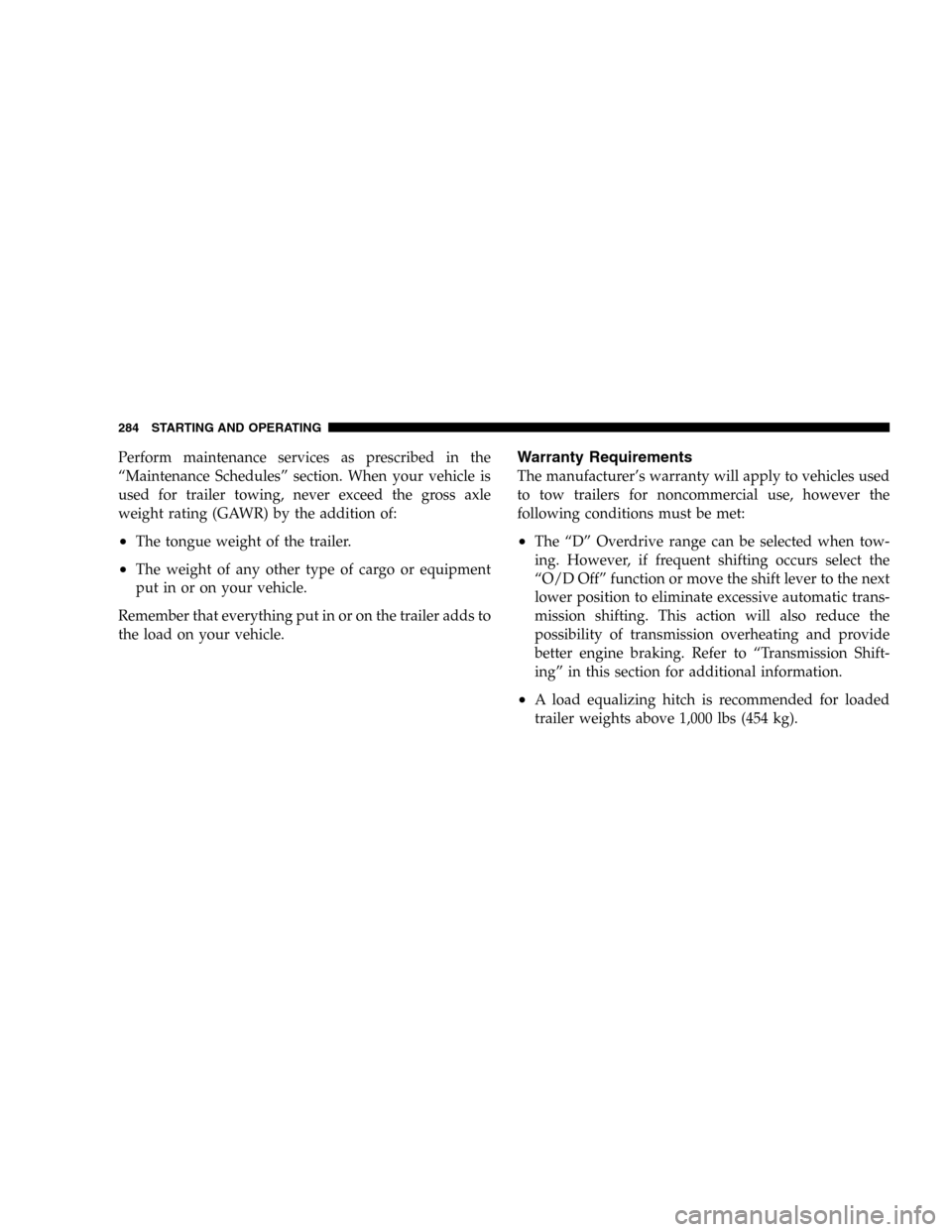
Perform maintenance services as prescribed in the
“Maintenance Schedules” section. When your vehicle is
used for trailer towing, never exceed the gross axle
weight rating (GAWR) by the addition of:
•The tongue weight of the trailer.
•The weight of any other type of cargo or equipment
put in or on your vehicle.
Remember that everything put in or on the trailer adds to
the load on your vehicle.
Warranty Requirements
The manufacturer’s warranty will apply to vehicles used
to tow trailers for noncommercial use, however the
following conditions must be met:
•The “D” Overdrive range can be selected when tow-
ing. However, if frequent shifting occurs select the
“O/D Off” function or move the shift lever to the next
lower position to eliminate excessive automatic trans-
mission shifting. This action will also reduce the
possibility of transmission overheating and provide
better engine braking. Refer to “Transmission Shift-
ing” in this section for additional information.
•A load equalizing hitch is recommended for loaded
trailer weights above 1,000 lbs (454 kg).
284 STARTING AND OPERATING
Page 285 of 424
CAUTION!
If the trailer weighs more than 1,000 lbs (454 kg)
loaded, it should have its own brakes and they
should be of adequate capacity. Failure to do this
could lead to accelerated brake lining wear, higher
brake pedal effort, and longer stopping distances.
WARNING!
Connecting trailer brakes to your vehicle’s hydraulic
brake lines can overload your brake system and
cause it to fail. You might not have brakes when you
need them and could have an accident.
•Whenever you pull a trailer, regardless of the trailer
size, stop lights and turn signals on the trailer are
mandatory for motoring safety.
•Follow the maintenance intervals in schedule “B” for
changing the automatic transmission fluid and filter, if
you REGULARLY tow a trailer for more than 45
minutes of continuous operation.
STARTING AND OPERATING 285
5
Page 287 of 424
RECREATIONAL TOWING (BEHIND
MOTORHOME, ETC.)
Towing – 2WD Models
Recreational towing is not allowed.Towing with the
rear wheels on the ground can result in severe transmis-
sion damage.
Towing — 4WD Models
CAUTION!
Internal damage to the transfer case will occur if a
front or rear wheel lift is used when recreational
towing.
NOTE:The transfer case must be shifted into N (Neu-
tral), and the transmission must be shifted into P (Park)(for automatic transmission) or into any forward gear (for
manual transmission) for recreational towing.
Shifting Into Neutral (N)
Use the following procedure to prepare your vehicle for
recreational towing.
CAUTION!
It is necessary to follow these steps to be certain that
the transfer case is fully in N (Neutral) before
recreational towing to prevent damage to internal
parts.
1. Depress brake pedal.
2. Shift transmission into N (Neutral).
3. Shift transfer case lever into N (Neutral).
4. Start engine.
STARTING AND OPERATING 287
5
Page 288 of 424
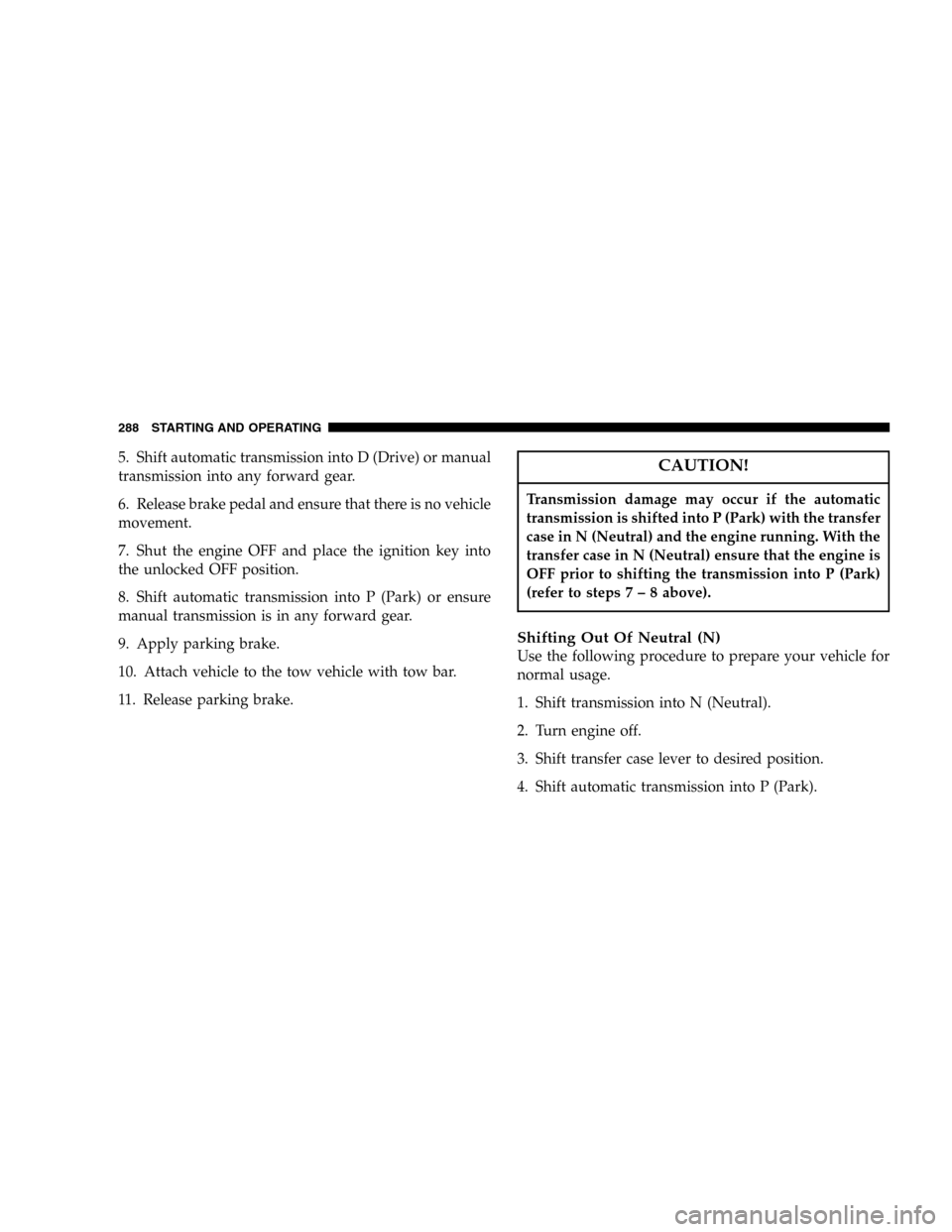
5. Shift automatic transmission into D (Drive) or manual
transmission into any forward gear.
6. Release brake pedal and ensure that there is no vehicle
movement.
7. Shut the engine OFF and place the ignition key into
the unlocked OFF position.
8. Shift automatic transmission into P (Park) or ensure
manual transmission is in any forward gear.
9. Apply parking brake.
10. Attach vehicle to the tow vehicle with tow bar.
11. Release parking brake.CAUTION!
Transmission damage may occur if the automatic
transmission is shifted into P (Park) with the transfer
case in N (Neutral) and the engine running. With the
transfer case in N (Neutral) ensure that the engine is
OFF prior to shifting the transmission into P (Park)
(refer to steps7 – 8 above).
Shifting Out Of Neutral (N)
Use the following procedure to prepare your vehicle for
normal usage.
1. Shift transmission into N (Neutral).
2. Turn engine off.
3. Shift transfer case lever to desired position.
4. Shift automatic transmission into P (Park).
288 STARTING AND OPERATING
Page 289 of 424
5. Start engine.
6. Shift automatic transmission into D (Drive) or manual
transmission into any forward gear.
WARNING!
You or others could be injured if you leave the
vehicle unattended with the transfer case in the N
(Neutral) position without first fully engaging the
parking brake. The transfer case N (Neutral) position
disengages both the front and rear driveshafts from
the powertrain and will allow the vehicle to move
regardless of the transmission position. The parking
brake should always be applied when the driver is
not in the vehicle.
CAUTION!
Do not use a bumper mounted clamp-on tow bar on
your vehicle. The bumper face bar will be damaged.
SNOW PLOW
Snow plows, winches, and other aftermarket equipment
shouldnotbe added to the front end of your vehicle. The
airbag crash sensors may be affected by the change in the
front end structure. The airbags could deploy unexpect-
edly or could fail to deploy during a collision.
STARTING AND OPERATING 289
5